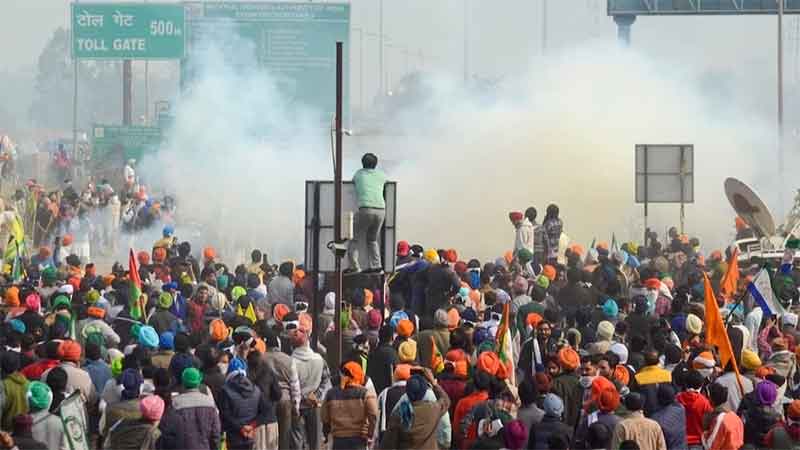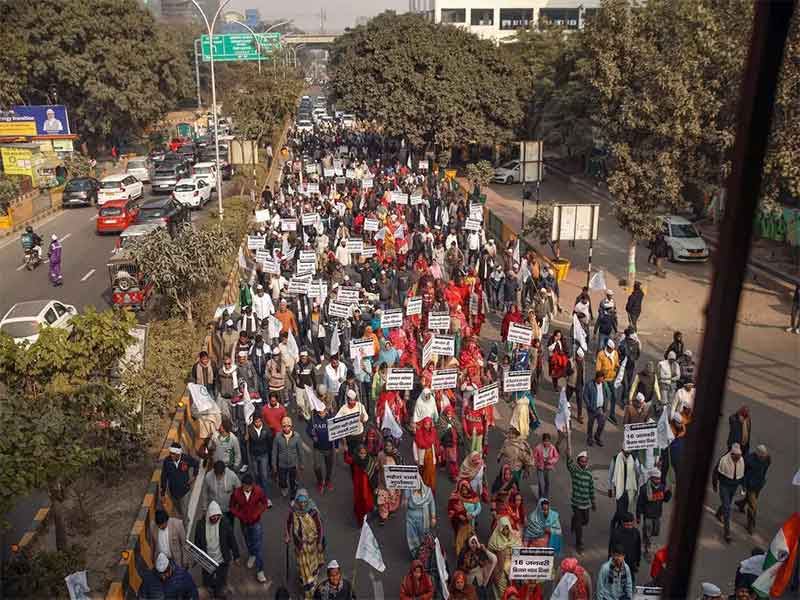
The Kisan Andolan is closing in on nine months – braving deeply disturbing times, braving weather extremities, braving police brutalities, braving government’s insouciance and subterfuge, braving the dark Covid clouds, braving the despair of over 500 compatriot deaths. Nine months! Displaying a clear understanding on the subject and its issues, and a clearer sense of purpose. Not for a day frustrated by the Government’s endless invitations and meaningless meetings therein. Not giving-in to the govenment’s ploy to – what else! – divide the farmers, and quickly acting on the chinks appearing in its own ranks. No other protest or movement for a long, long time has been as resilient and steadfast. And at the same time, not for a day, the farmers forgot to plough their fields, tend to their crops and cattle back home nor forgot to live it out, sing and laugh at the Delhi borders.
Not just that, the movement widened its scope and network to include the concerns of labour and deliberate over the other questions of and threats to democracy, culture, religion and secularism. Most importantly, the movement has not given-in to government’s every attempt to have it turn vitriolic, become foul-mouth, damage property, hinder public movement or disturb public peace. It has eschewed all violence and remained deeply peaceful. This is what, most probably, has somewhat stayed the States’ hand and garnered wider national and global attention and support.
The movement has also been remarkably creative – be it, among others, the library or the daily news bulletin at the site or the recent Kisan Sansad, which only accentuated the farce and hollowness of the country’s parallel parliament in session barely a few kilometres away.
While the Kisan Sansad, is part of the Andolan’s evolution as a very important exercise, which provided wide exposure, it also underlines the unfortunate need for the movement to perpetually remain creative, forever invent and re-invent itself, its experiments and methods to remain in contention amidst a one-new-issue-daily that engulfs the country. The Kisan Sansad, despite its intentions and impact can, at best, remain only or largely symbolic.
So, what can be the road ahead?
The government, of course, will continue to turn a blind eye to (or actually keep one eye on) its non-state accomplices to do its bidding – to instigate, humiliate and break the farmers – as happened recently at the Jantar Mantar. And then there will always be the prime minister to make periodic statements, such as his recent anguish over the plight of the small farmers.
During the Bengal electioneering, agriculture woes and the three Farm Laws (actually Three Agro-Corporate Laws) may not have been the most important but were an issue never-the-less and members of the Sanyukt Kisan Morcha visited some constituencies in the state. However, what impact their visit had cannot be (and has not been) adequately guaged. The prospective elections early next year in five states offer more scope and visibility on that front, particularly in Uttar Pradesh (despite India Today’s survey stating Yogi’s increase in popularity or acceptability) and Uttrakhand. But, intervening in elections can only be a short-term solution, unless farmers across the communities realize that they need to vote as farmers and not on the basis of religion, caste, community, kith-n-kin, imaginary issues and enemies, chicken-n-liquor, other freebies, et.al. It is important that farmers and agriculture must become a vital constituency.
For any meaningful and long-term change, the Kisan Andolan must concentrate and consolidate whatever progress made on various fronts and aspects. The question of small farmers and big farmers is real, and their divide has always been an undercurrent – a socio-economic-politico divide. True, the three Agro-Corporate Laws will ultimately marginalize, if not wipe out for all practical purposes the entire farming community, these need to be addressed in their wider context, hidden agendas and unsuspecting implications. The small farmers have already been pushed to the very margins of the society, and the big farmers need to consciously accept and confess that knowingly or unknowingly, they have had a role in that. Sanyukt Kisan Morcha must address this divide headlong and frame the steps that need to be taken, sooner than later.
The question of supporting the concerns of other sectors, such as labour (formal and informal sectors), also needs to be strengthened and pursued more vigorously to understand not just the long-term implications and inter-relatedness of the various laws (policies, plans, programmes, promises) concerning both sectors including their affect on the overall societal deprivation. Similar alliances must be sought across banking, insurance, transport and many other sectors.
There has been some airing of views on whether the farmers should enter the political, electoral fray. Inevitable, tempting or important as the question may be, fortunately, it hasn’t taken centrestage. And though it cannot entirely be brushed under the carpet, the question must bide its time for now. There is much other work that demands more immediate attention.
For the past several years, the farmers across the country have been increasingly protesting their state of misery, and Jantar Mantar has seen large farmer gatherings from different states on several occasions. Indeed, but for those protests, the current Andolan may not truly have been possible. Covid19 put a break to large all-India participation and all that. Now, there is talk of Corona’s third wave. This threat or fear could be as much real as it could also be a straw for the government to hang on; and the government will do everything for whatever real or supposed benefits it may derive from it. Over the past nine months, at the Delhi borders there has been representative and sporadic participation and attendance by farmers from other states, but this coming together needs to increase and also become more visible. To re-begin with, protests must be carried out (and must be seen to be carried out) in as many states as can be; and when time and situation permit, begin to move towards Delhi.
In this 75th year of the country’s independence, can the farmers look to history and the country’s freedom struggle for some light on the road ahead? This question becomes pertinent as the current Kisan Andolan resonates, both literally as well as symbolically, the concerns and the clarion call of the 1942 Quit India Movement. Remarkably peaceful and non-violent that the Kisan Andolan has been, it must graduate to a Satyagrah in its truest sense.
Should it come to that, remember, non-cooperation and civil disobedience were important courses of action in the country’s freedom struggle. Yes?
Biju Negi,Beej Bachao Andolan and Sarvoday/Hind Swaraj Manch. Uttarakhand based Writer-Activist on small farmer concerns and Gandhian thought















































